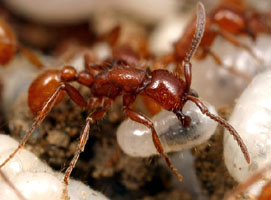Ecitoninae
New World army ants



This tree diagram shows the relationships between several groups of organisms.
The root of the current tree connects the organisms featured in this tree to their containing group and the rest of the Tree of Life. The basal branching point in the tree represents the ancestor of the other groups in the tree. This ancestor diversified over time into several descendent subgroups, which are represented as internal nodes and terminal taxa to the right.

You can click on the root to travel down the Tree of Life all the way to the root of all Life, and you can click on the names of descendent subgroups to travel up the Tree of Life all the way to individual species.
For more information on ToL tree formatting, please see Interpreting the Tree or Classification. To learn more about phylogenetic trees, please visit our Phylogenetic Biology pages.
close boxCharacteristics
The Ecitoninae are characterized by the following derived traits (Bolton 2003):- Orifices of abdominal spiracles IV-VII directed posteriorly
- Pygidium small or very small, usually merely a narrow U-shaped sclerite
- Male with sharply defined presclerites on abdominal segments IV-VII; abdominal sternite VII hypertrophied; abdominal sternite VIII internalized and bilobate apically
- Male biaculeate hypopygium mostly or entirely exposed
- Basal ring of male genital capsule hypertrophied
References
Bolton, B. 1990b. Army ants reassessed: the phylogeny and classification of the doryline section. Journal of Natural History 24: 1339-1364.
Bolton, B. 1994. Identification Guide to the Ant Genera of the World. Cambridge, MA: Harvard University Press.
Bolton, B. 1995. A New General Catalogue of the Ants of the World. Cambridge, MA: Harvard University Press.
Bolton, B. 2003. Synopsis and Classification of Formicidae. 370 pp. Memoirs of the American Entomological Institute, Vol. 71. Gainesville, FL.
Brady, S. 2003. Evolution of the army ant syndrome: the origin and long-term evolutionary stasis of a complex of behavioral and reproductive adaptations. PNAS 100(11): 6575-6579.
Gotwald, W. H., Jr. 1979. Phylogenetic implications of army ant zoogeography (Hymenoptera: Formicidae). Annals of the Entomological Society of America. 72 (4): 462-467.
Gotwald, W. H., Jr and A. W. Burdette. 1981. Morphology of the male internal reproductive system in army ants: phylogenetic implications. Proceedings of the Entomological Society of Washington 83: 72-92.
Hölldobler, B. and E. O. Wilson. 1990. The Ants. Cambridge, MA: Harvard University Press.
Perfil'eva, K. S. 2002. Wing venation in army ants (Hymenoptera, Formicidae) and its importance for phylogeny. Zoologicheskii Zhurnal 81 (10): 1239-1250.
Wheeler, G. C. & Wheeler, J. 1976. Ant larvae: review and synthesis. Memoirs of the Entomological Society of Washington 74: 1-108.
Information on the Internet
Title Illustrations

| Scientific Name | Neivamyrmex californicus |
|---|---|
| Location | U.S.A. (California) |
| Sex | Female |
| Life Cycle Stage | Worker |
| Copyright |
© 2003 Alex Wild

|
| Scientific Name | Eciton burchelli |
|---|---|
| Location | Paraguay |
| Sex | Female |
| Life Cycle Stage | Major, minor workers |
| Copyright |
© 2003 Alex Wild

|
About This Page
Page copyright © 2004
 Page: Tree of Life
Ecitoninae. New World army ants.
The TEXT of this page is licensed under the
Creative Commons Attribution-NonCommercial License - Version 3.0. Note that images and other media
featured on this page are each governed by their own license, and they may or may not be available
for reuse. Click on an image or a media link to access the media data window, which provides the
relevant licensing information. For the general terms and conditions of ToL material reuse and
redistribution, please see the Tree of Life Copyright
Policies.
Page: Tree of Life
Ecitoninae. New World army ants.
The TEXT of this page is licensed under the
Creative Commons Attribution-NonCommercial License - Version 3.0. Note that images and other media
featured on this page are each governed by their own license, and they may or may not be available
for reuse. Click on an image or a media link to access the media data window, which provides the
relevant licensing information. For the general terms and conditions of ToL material reuse and
redistribution, please see the Tree of Life Copyright
Policies.
- First online 20 March 2004
Citing this page:
Tree of Life Web Project. 2004. Ecitoninae. New World army ants. Version 20 March 2004 (temporary). http://tolweb.org/Ecitoninae/22207/2004.03.20 in The Tree of Life Web Project, http://tolweb.org/









 Go to quick links
Go to quick search
Go to navigation for this section of the ToL site
Go to detailed links for the ToL site
Go to quick links
Go to quick search
Go to navigation for this section of the ToL site
Go to detailed links for the ToL site